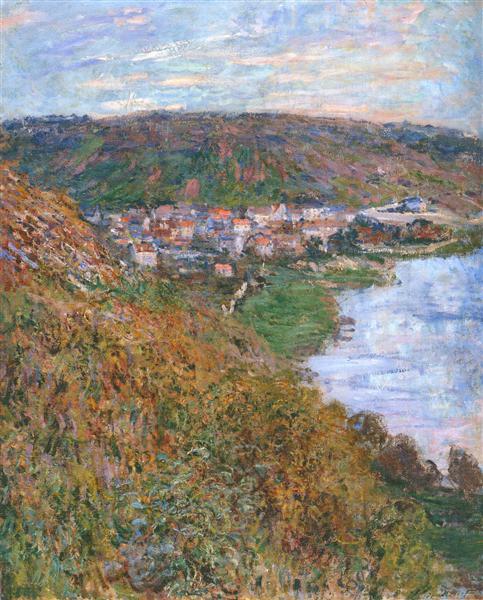Description
Claude Monet's 1880 painting "View over Vetheuil" is an iconic work that encapsulates the ethos of Impressionism through its treatment of color, light, and form. One of the leading exponents of this art movement, Monet delves into the exploration of visual perceptions of the landscape, employing his signature style of loose brushstrokes and vibrant colors that once caused controversy and ultimately defined a new era of art.
In this work, Monet presents a panoramic view of the village of Vetheuil, which is situated on the banks of the River Seine, with a dual focus: nature and architecture. The composition unfolds in a horizontal format that invites the viewer to scan the scene with their eyes. In the foreground, soft greens and yellows occupy space, suggesting a peaceful countryside, while the vegetation blends with the sky, creating a horizon that seems almost ethereal. The shape of the clouds, represented with applications of white and blue, suggests a light movement, a volatility that evokes the changing atmosphere of the air in the region.
The use of color is central to View over Vetheuil. Monet orchestrates a palette that ranges from soft pastels to more saturated hues, illuminating the nuances of the landscape. The sunlight, filtering through the landscape and reflecting off the river, lends an almost magical quality to the work, an effect Monet achieved through meticulous studies of optical light. The warm tones of the countryside contrast with the cool tones of the sky, reinforcing this vibrant atmosphere, creating a sense of visual harmony.
In the middle section of the painting, the village sits in an almost idyllic setting, its houses sketched in a vague manner, emphasizing the ephemeral nature of human structures versus the persistence of nature. Monet, by not employing excessive architectural detail, invites the viewer to perceive the village as part of a larger whole; a way of life in tune with the natural environment. This is, in a sense, a reflection of the philosophy of Impressionism: capturing not only what is seen, but also the ephemeral experience of light and moment.
A fascinating aspect of “View over Vetheuil” is its autobiographical connection to Monet’s life. During this period, Monet was living in Vetheuil and facing personal and financial challenges. However, these difficulties were transformed into a creative stimulus and a source of inspiration. The work can be seen not only as a landscape, but as a testimony to Monet’s emotional journey at a crucial moment in his life.
The absence of observable human figures encourages the interpretation of this landscape as a haven of peace and reflection. There are no distractions, just a pure connection with the surroundings. This could suggest Monet's desire to find solace in nature, underlining the intimate relationship between the artist and his environment in a period of transition.
“View over Vetheuil” stands, then, as a mirror of the Impressionist philosophy: an attempt to capture the moment, the light, and the essence of place. Through his ingenious visual approach and vibrant palette, Monet not only glorifies the landscape of Vetheuil, but also invites the viewer to experience the transformation and fleeting moment that characterizes life itself. In the context of art history, this work stands out as an essential component of the narrative of Impressionism, representing both an evolving artistic style and an artist’s intimate connection with his environment and his world.
KUADROS ©, a famous painting on your wall.
Hand-made oil painting reproductions, with the quality of professional artists and the distinctive seal of KUADROS ©.
Painting reproduction service with satisfaction guarantee. If you are not completely satisfied with the replica of your painting, we will refund 100% of your money.

